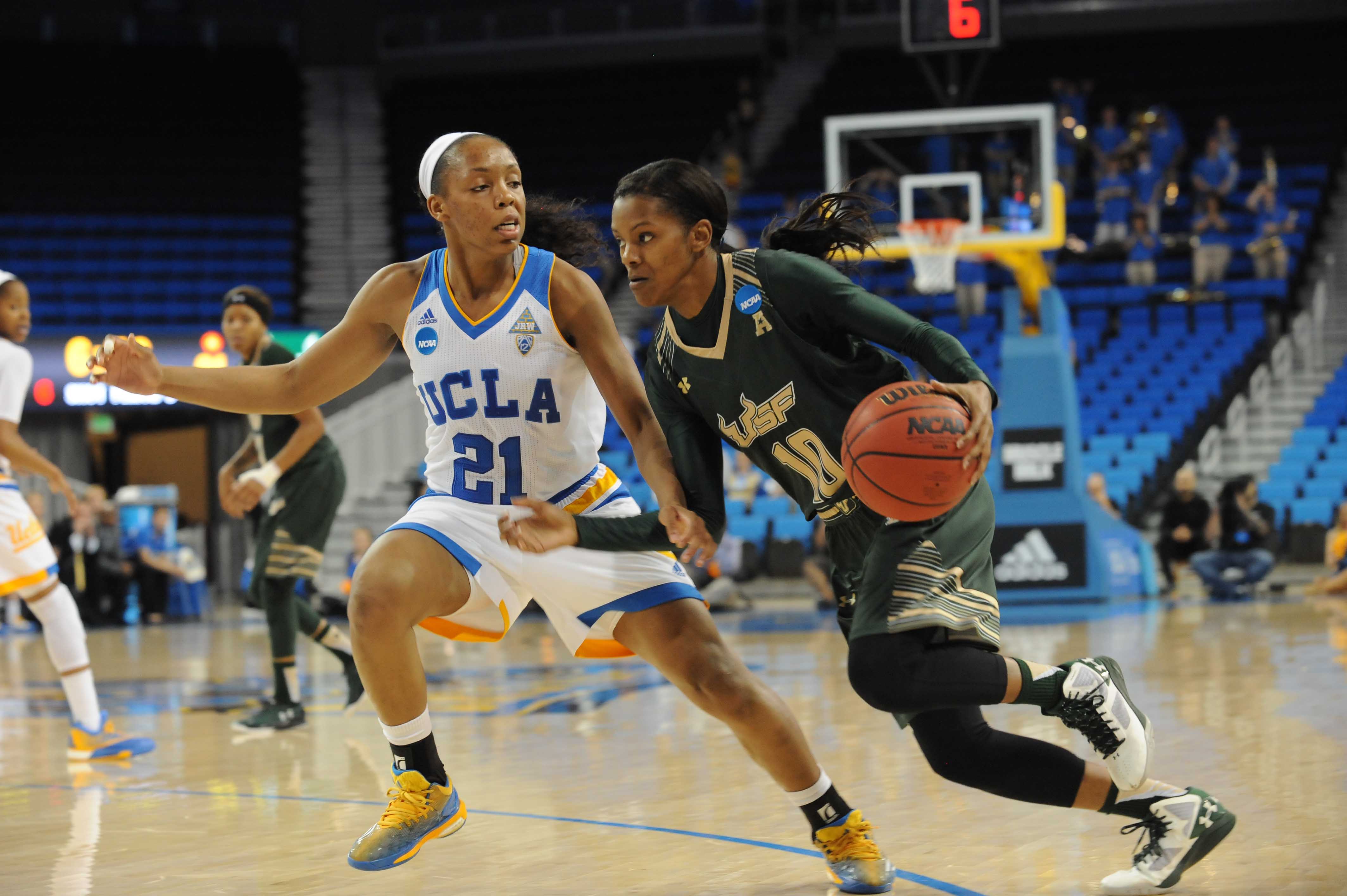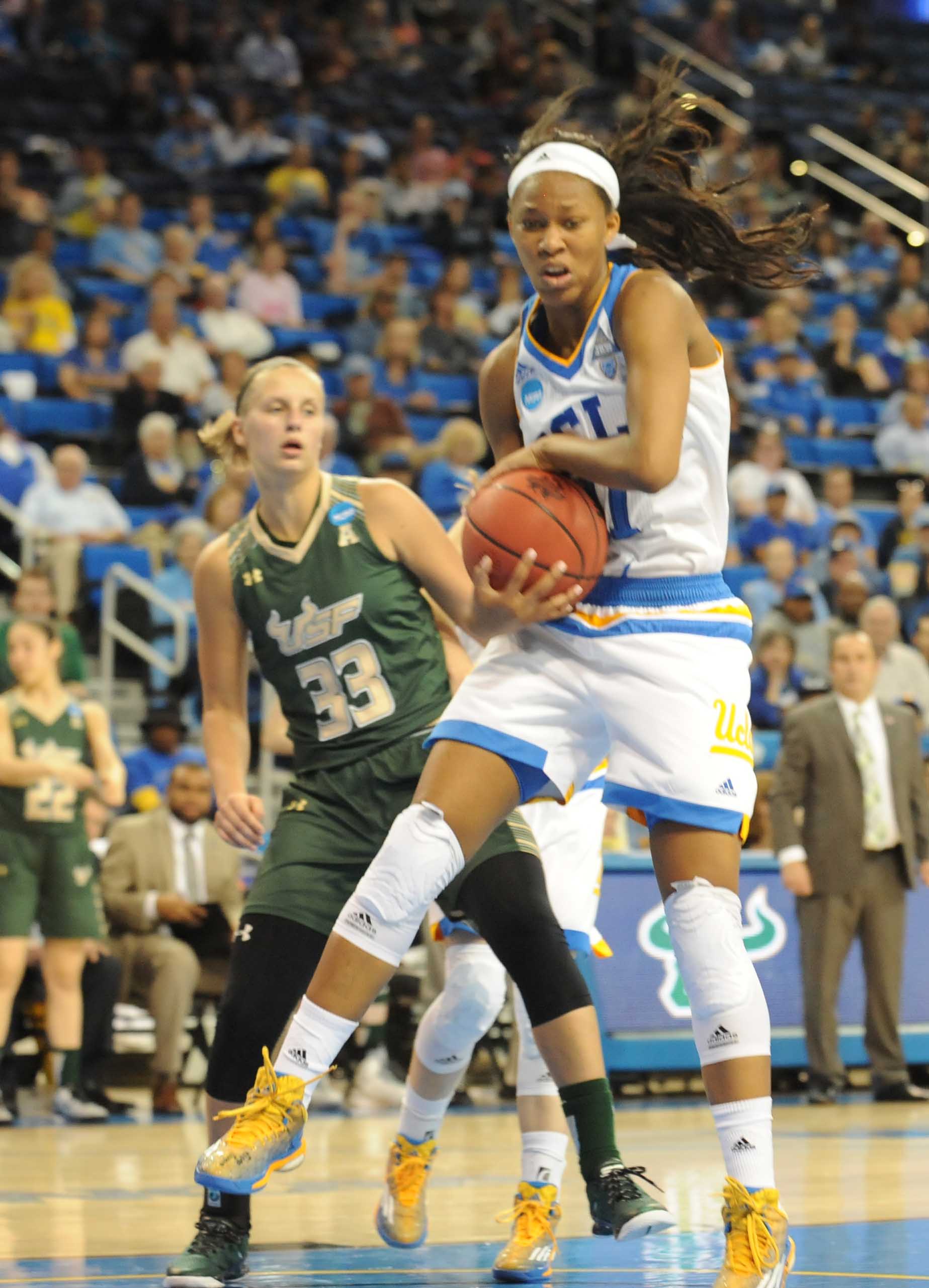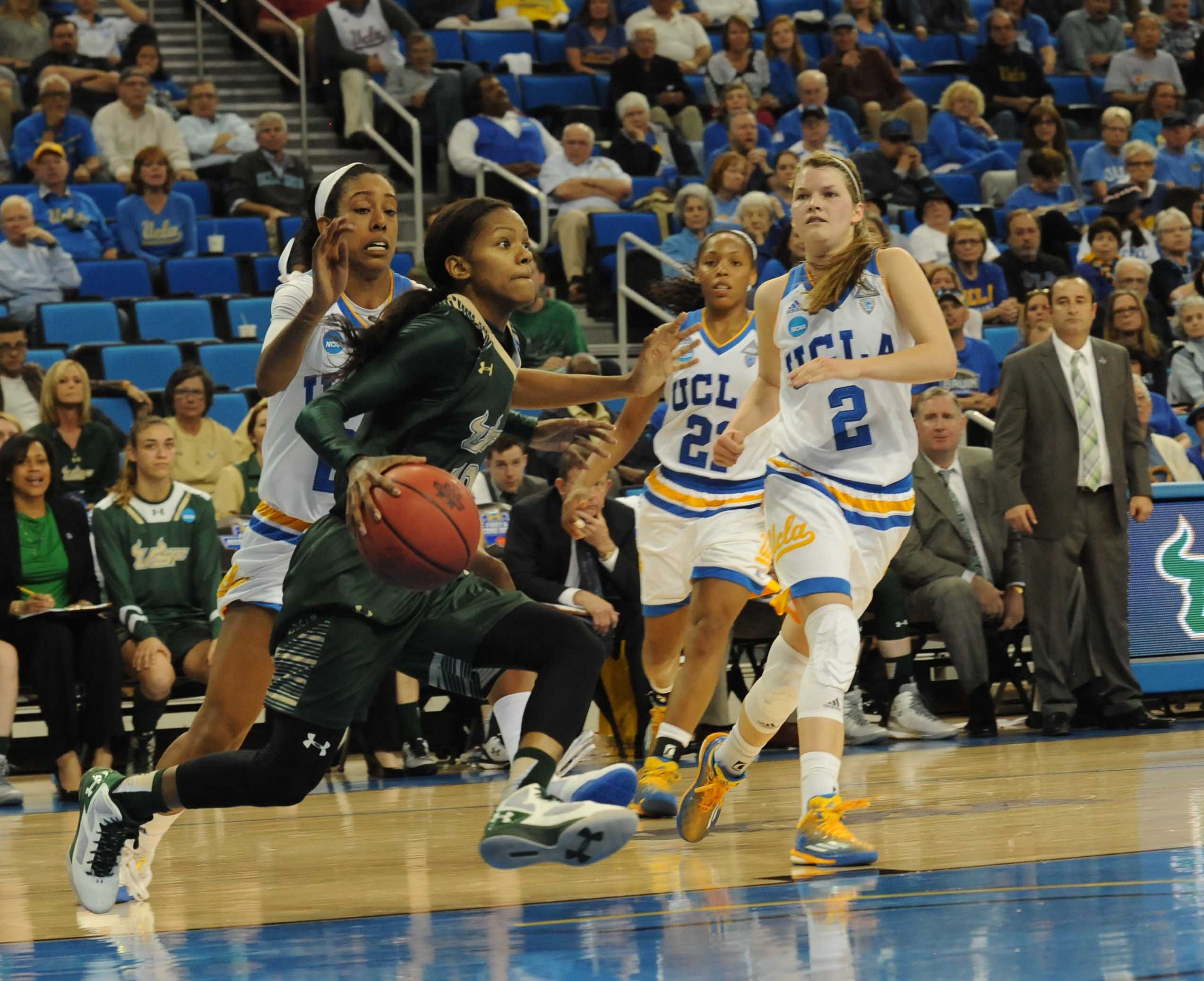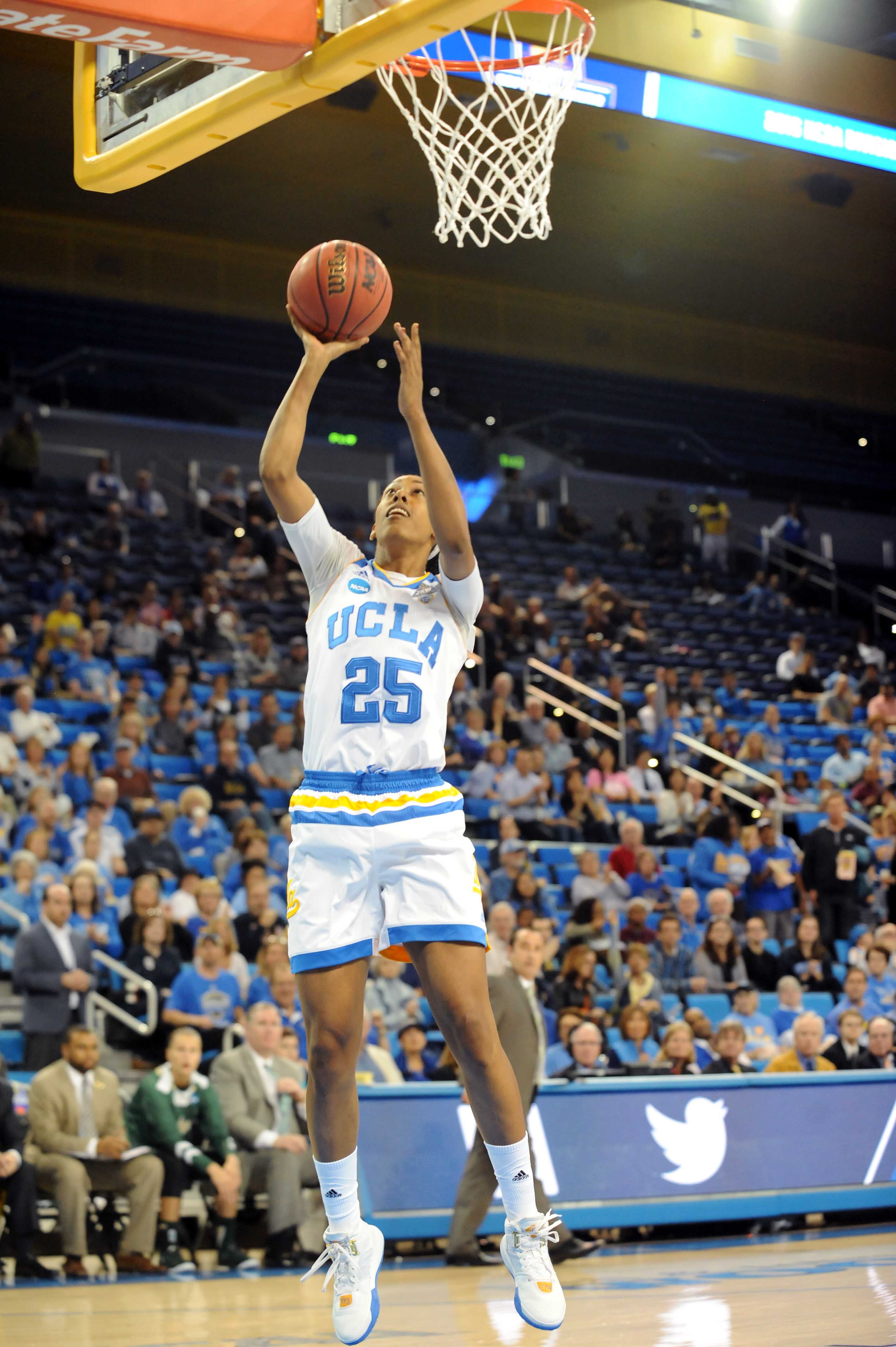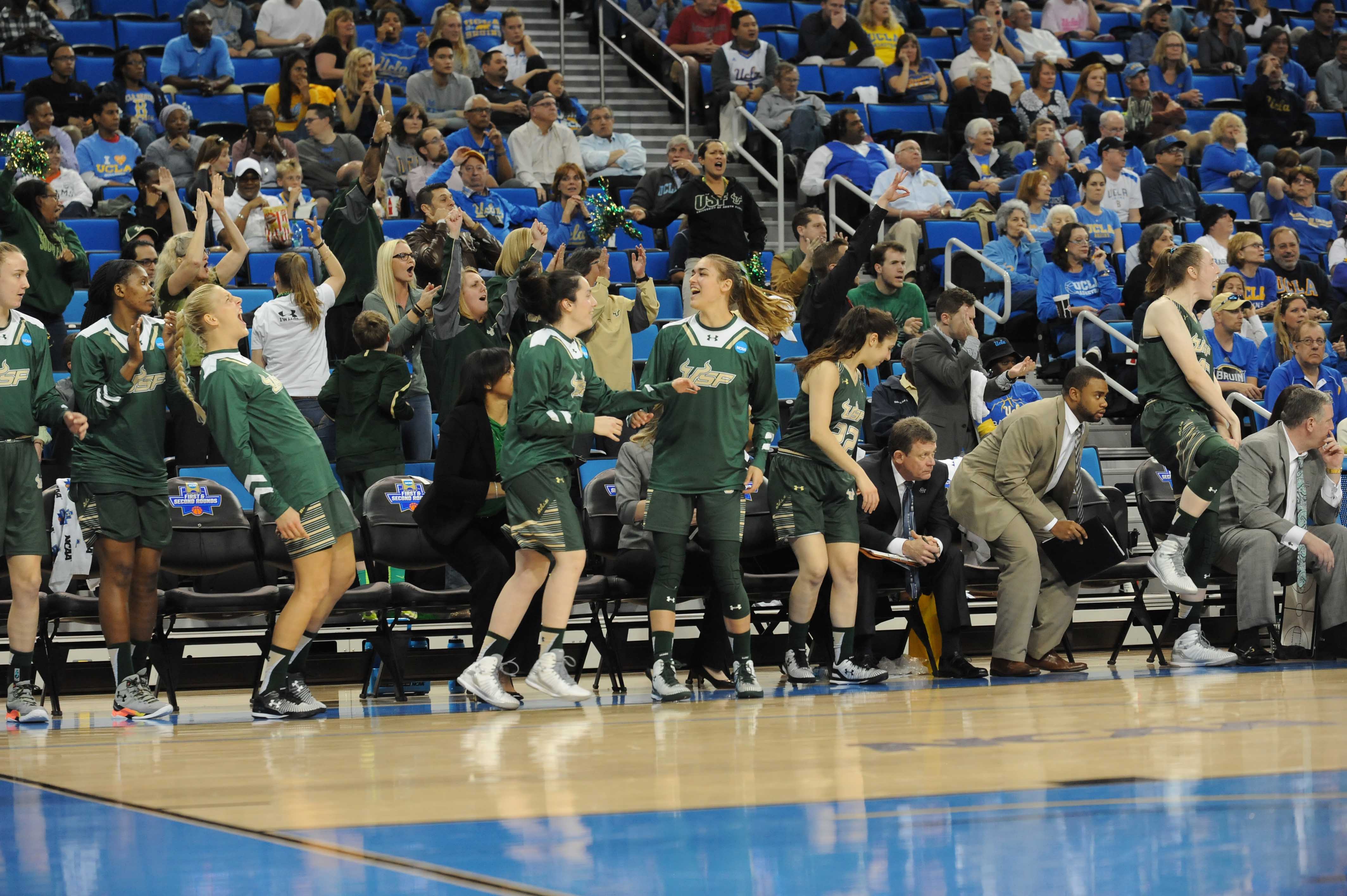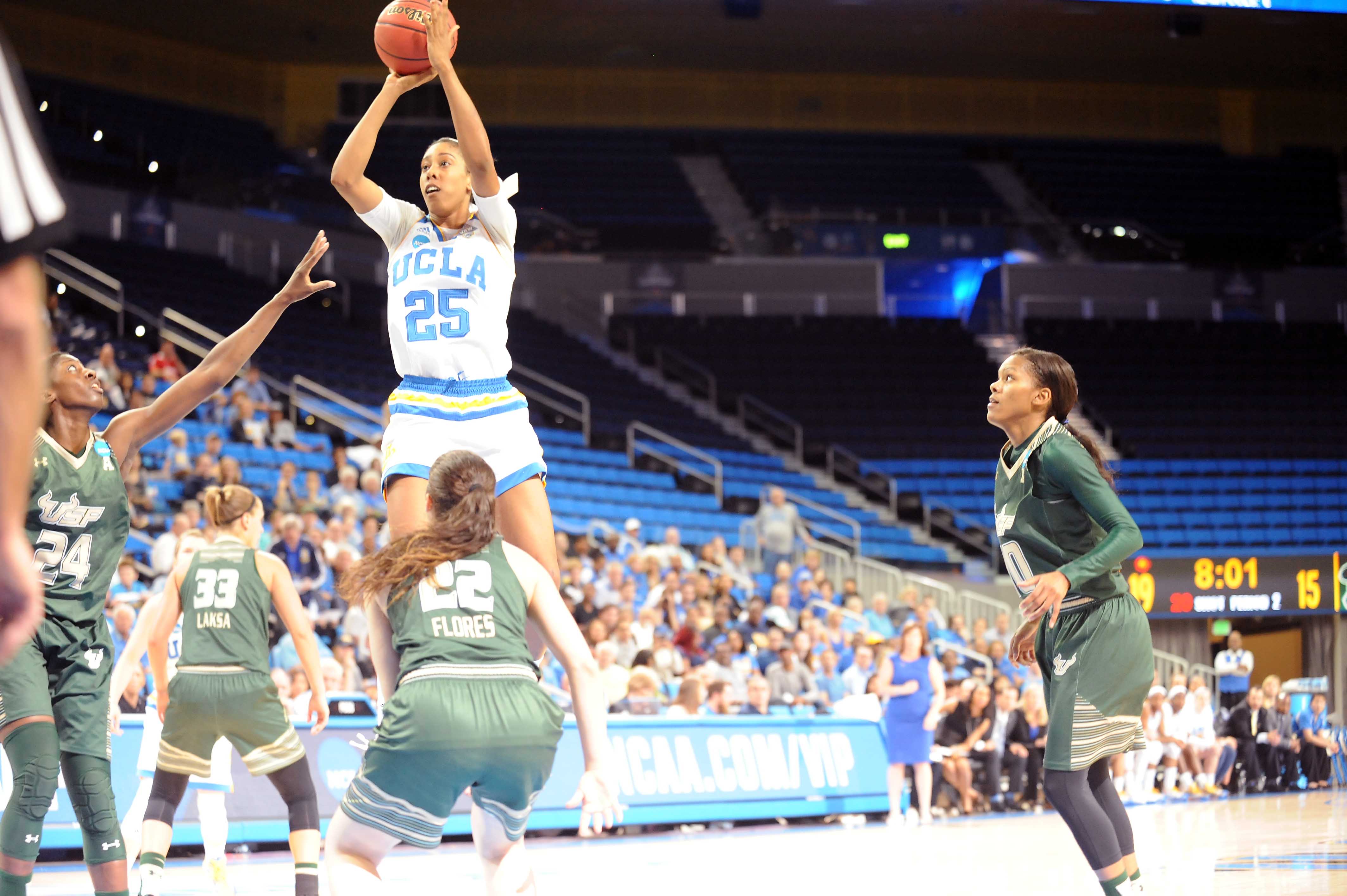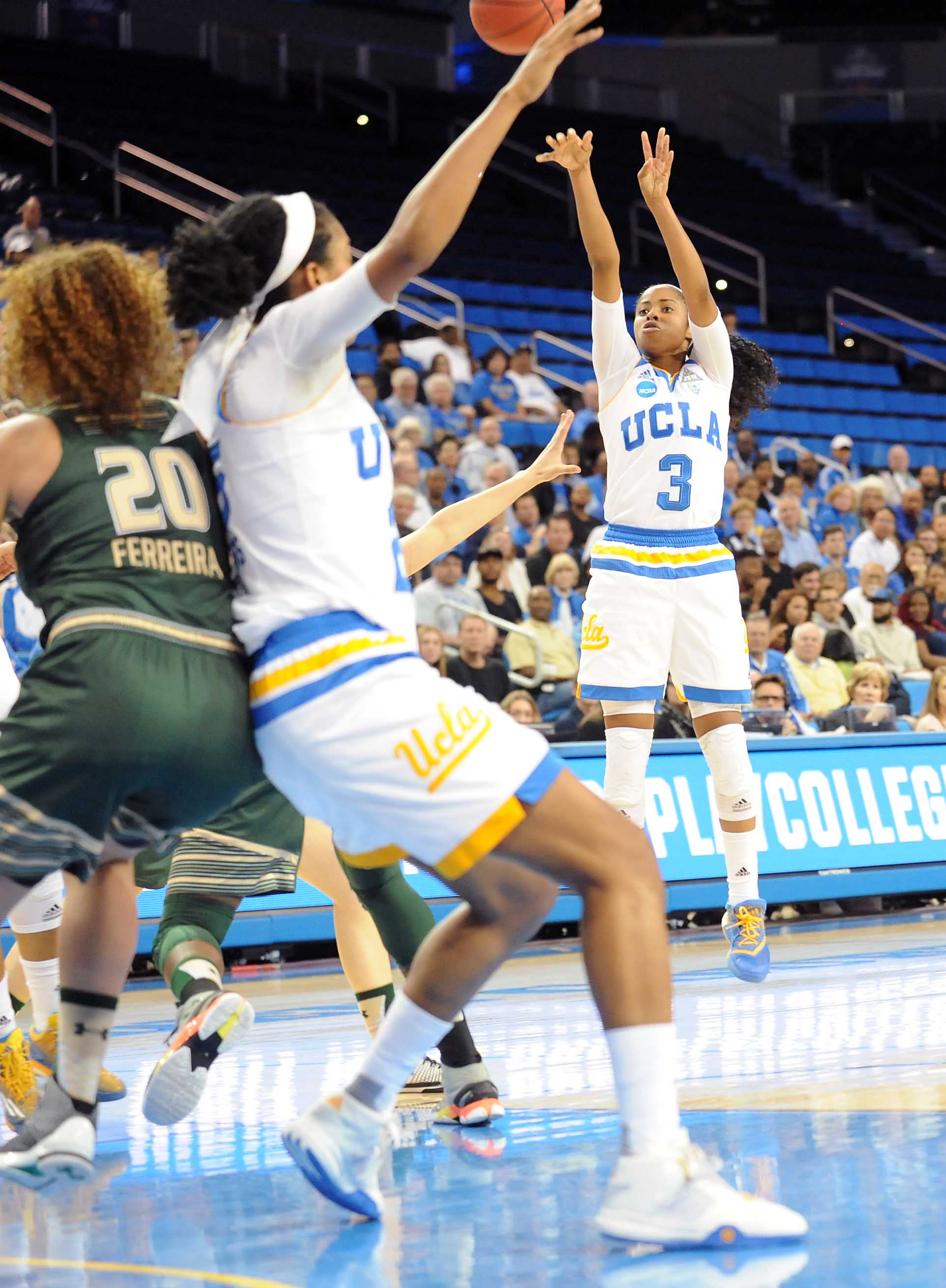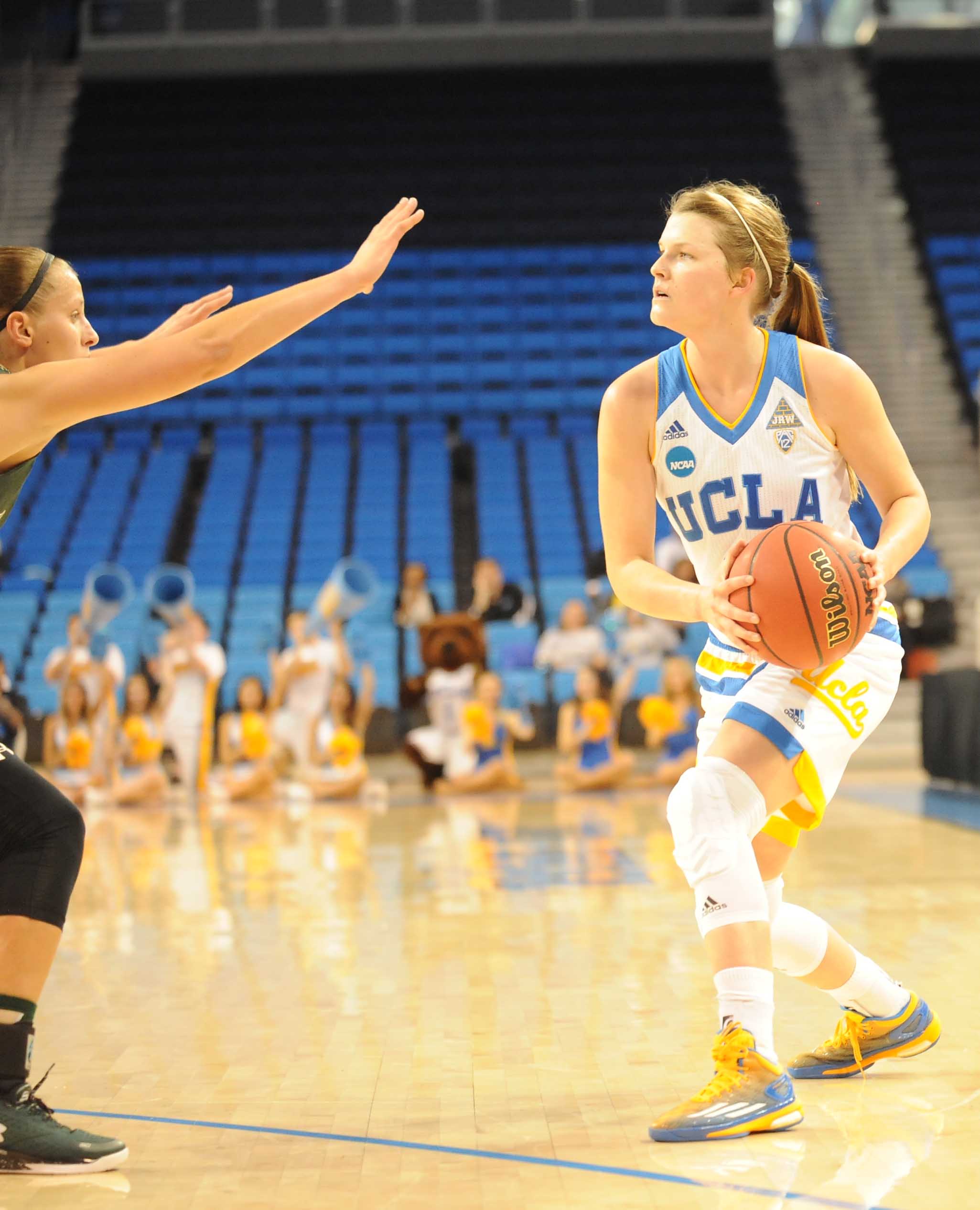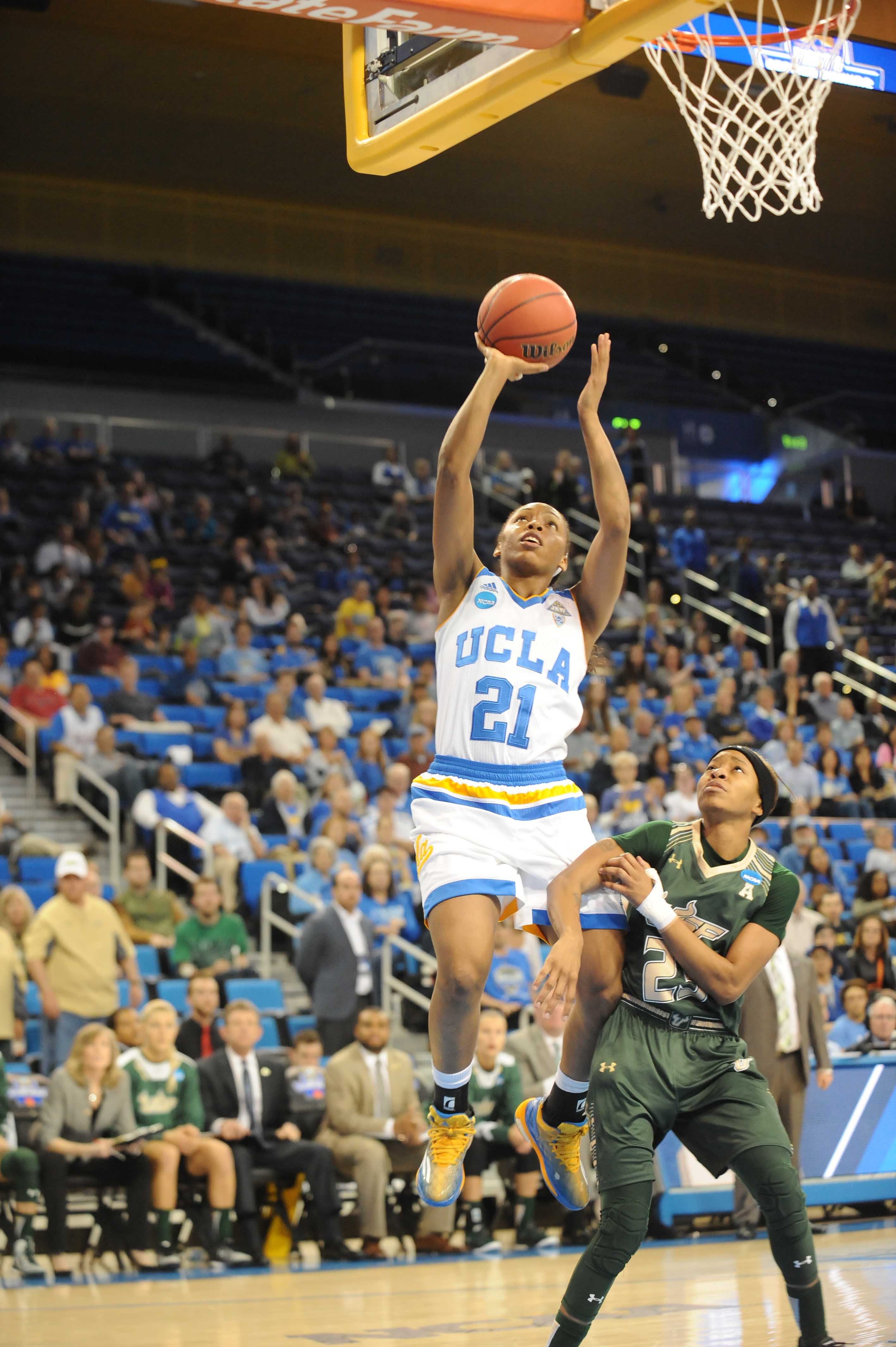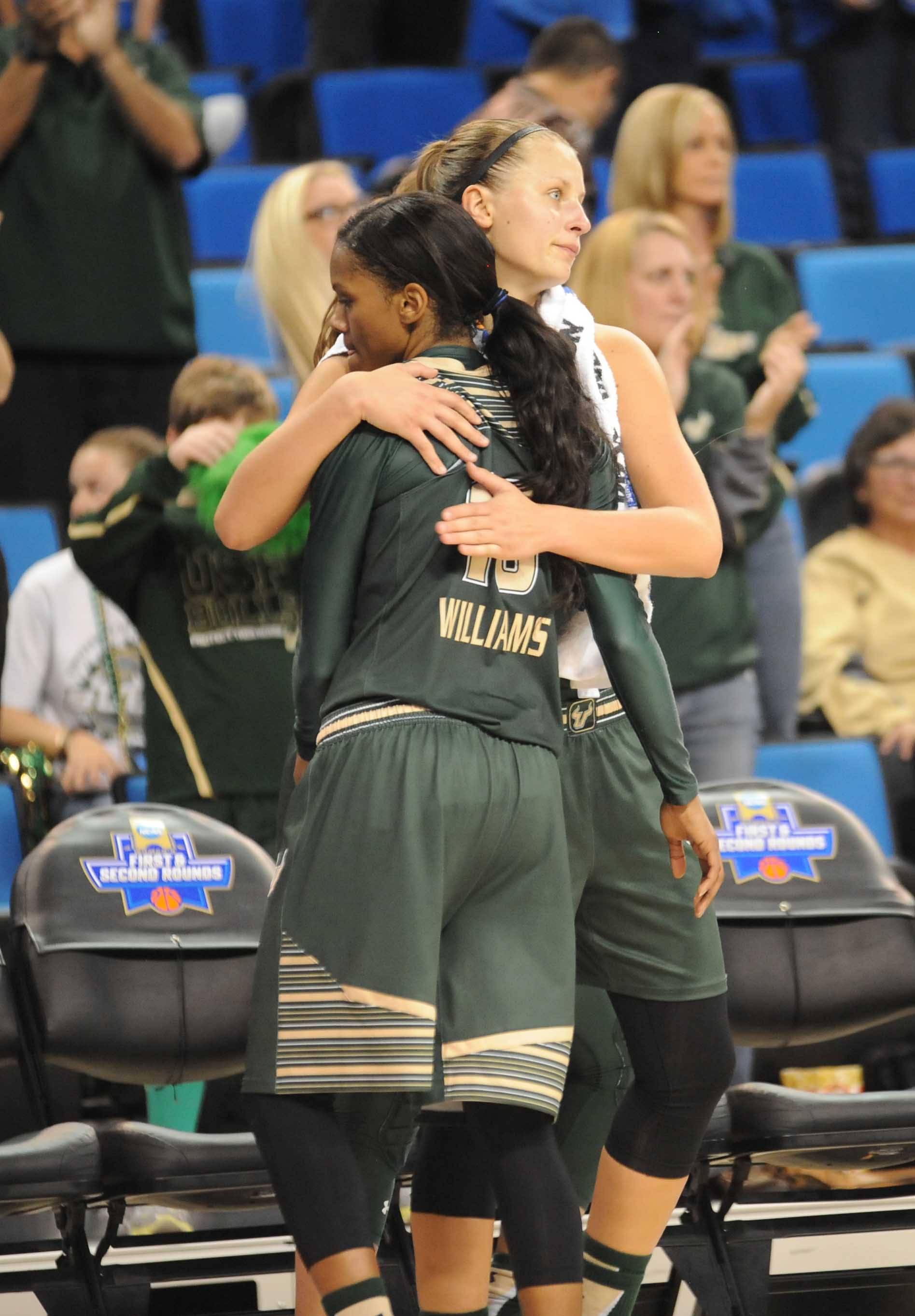UCLA continues banner season, heads into the Sweet 16 for first time in 17 years
WESTWOOD, Calif. — The third-seeded UCLA Bruins (26-8) are headed to the Sweet 16 of the NCAA Division I Women’s Basketball Tournament for the first time in 17 years after outlasting the University of South Florida (24-10), 72-67, in the second round on Monday evening at Pauley Pavilion in Westwood, Calif. The Bruins now travel to Bridgeport, Conn., to take on No. 2-seeded Texas (30-4) on Saturday, March 26.
Monday night’s game at Pauley was, in the words of South Florida head coach Jose Fernandez, “a tale of two halves.” The sixth-seeded Bulls of USF got to the second round after squeaking past Colorado State, 48-45, in a game that, despite the low score, was a cliff-hanger decided by mere inches only after a potentially game-tying 3-pointer by the Rams’ Sofie Tryggedsson kissed the iron and rolled away harmlessly as time expired.
That game demonstrated two things quite clearly: First, Colorado State, a team that had suffered only one loss in its regular season, was badly under-seeded at No. 11. Second, USF guard Courtney Williams, a Naismith and Wooden Award watch-lister, is the real deal.
Coming off the bench (neither Fernandez or Williams would say why), Williams posted 31 points in Saturday’s opening round victory, on 12-29 (41.4 percent) shooting from the field and a perfect 6-6 from the charity stripe. Her 1-6 marksmanship from 3-point range was offset by six rebounds, an assist, a block and four steals.
Williams’ performance, while impressive, left some pundits predicting trouble ahead for the Bulls. The mathematically inclined will quickly recognize that Williams supplied nearly two-thirds of South Florida’s total scoring (64.6 percent, to be precise). Recognizing that Williams was likely to get her points regardless of their tactics, the Rams focused their defense on trying to stop any one else in a South Florida uniform from contributing.
They very nearly succeeded. No USF player other than Williams managed double figures. The Bulls, as a team, collectively shot just 30 percent (18-60) from the field and an ugly 16.7 percent from beyond the arc. With the Bulls relying so heavily on Williams for their offensive production, what would happen when they encountered a team with the defensive chops to keep Williams under wraps? Or suppose Williams simply had a bad shooting night? What would happen then?
For the first 20 minutes of tonight’s second-round contest with UCLA, we got to find out. In the opening quarter, Williams couldn’t buy a bucket. The Bruins rolled out to a 7-0 lead in a little more than two minutes, the run fueled by three UCLA steals, and Fernandez called time to talk things over.
Out of the huddle, the Bulls’ Kitija Laksa drained a trey, South Florida stepped up its defense and began taking better care of the basketball, and the Bruins began making a few mistakes of their own. With four minutes and change remaining in the period, Shaleth Stringfield dropped in a layup to make the score 9-8, and the Bulls were back in the ballgame.
But as would remain the case on this night in which the Bruins led from opening tip to final buzzer, each time South Florida threatened, UCLA would answer. Emphatically. On this occasion, the response was a 3-pointer from six-foot-one freshman guard Kennedy Burke, who had a second straight great night off the bench.
From there, the two sides traded shots, with the Bruins up four (17-13) at the end of the first 10 minutes. Throughout that stretch, Williams, one of the top-10 scorers in the nation who averages more than 22 points per game, had been completely blanked, going 0-7 from the field. Though Alisia Jenkins stepped into the void, contributing seven points on 2-3 from the floor and 3-3 from the line, in the opening quarter, nearly singlehandedly keeping South Florida in the game, as a team, the Bulls’ shooting was simply dreadful (4-15, or 26.7 percent, for the quarter).
The Bulls’ survival of their opening-period drought was aided by the fact that after their first two hot minutes, UCLA’s marksmanship was only marginally better than South Florida’s. The Bruins’ netted just seven of their 24 (29.2 percent) first-quarter shots, with star guard Jordin Canada suffering her second consecutive poor shooting night, landing none of her five first-quarter field-goal attempts Nirra Fields (six points, on 2-6 shooting) and Monique Billings (six points, on 3-8 from the floor) carried the laboring oar for the Bruins in the early going.
Williams’ woes continued throughout the second stanza. She finally found the bottom of the net a little more than a minute into the frame, and followed the make with a layup a minute later. But if Fernandez thought the Bulls’ shooting woes were over, he would find himself sorely mistaken. Williams finished the half with just six points to her credit, and those came on volume shooting that had not been in evidence during South Florida’s opening round win. Many of her shots were rushed, forced and out-of-position. The superstar managed a subpar 3-15 (20 percent) from the field for the half, including a dismal 0-4 from the perimeter.
Moreover, while Williams continued to struggle, the rest of the South Florida cast cooled even further. Jenkins contributed another four points, all of which came at the foul line. Apart from the beleaguered Williams, only Laksa managed even a single field goal in the second frame. It seemed impossible for a team of South Florida’s caliber, but its collective field-goal shooting actually worsened, with a barrage of ill-considered long-ball attempts (0-5 for the period) contributing to their troubles.
Meanwhile, UCLA (with the notable exception of the team’s leading scorer Canada, who averages 15.9 points a game but had yet to net a single shot by intermission) began to heat up significantly. The Bruins’ shooting improved to a respectable 40.5 percent (17-42) from the floor and 50 percent (4-8) from beyond the arc for the half, with a hot 10-18 (55.6 percent) pace fueling the uptick.
The results were predictable: UCLA led by 16 points, 40-24, heading into the break and the game appeared to be headed for a blowout.
All the more so when the teams took to the floor for warm-ups shortly before the second half got underway. I counted Williams’ shots: Though obviously uncontested at that point, she was netting only one out of three. Her body language screamed of frustration. All in all, it did not bode well for a second-half South Florida comeback.
But that’s exactly what the audience of 1,656 mostly Bruin faithful would witness as the third quarter got underway. South Florida opened the third quarter on a 9-0 run, fueled by a jumper, a steal and a trey from Jenkins, and a layup from Laksa, and capped by a put-back by Williams, who rebounded her own initial miss, then sealed the deal. A little more than three minutes into the period, South Florida had whittled the Bruin lead to single digits (33-40), and this time it was UCLA head coach Cori Close calling for time to regroup.
Out of that huddle, Canada netted her first bucket of the game, but Williams responded at the other end of the floor with back-to-back 3-pointers to cut it to a one-possession (39-42) game, and the excitement on the South Florida bench was palpable.
UCLA’s Kari Korver, whom Close described as her team’s hardest worker, put a damper on some of that enthusiasm with a 3-ball of her own. Jenkins and UCLA’s Monique Billings traded a layup for a jumper, but from there, the remainder of the third-period scoring took place at the charity stripe, until Jenkins closed the quarter with a jumper with six seconds remaining. When the dust settled, South Florida was still very much in contention, down by just three points, 47-50.
Seven of South Florida’s points in this third-quarter comeback came off turnovers (to one point for UCLA), 11 more (again to just one for UCLA) came off the offensive glass as second-chance points. Uncharacteristically, the Bruins netted just three field goals in the entire frame.
Williams had landed that many all by herself, and two of those buckets were treys. She also paid her first four visits to the line, where she was perfect, and by the end of the period, she boasted 18 points, second only to her teammate Jenkins’ 19.
Across the board, the shooting remained abysmal, with only Jenkins, by then 6-10, having much to write home about. Williams had stepped things up to 3-9 from the field, and 2-2 from the arc, but still stood at a just 25 percent (6-24) from the field, slightly worse than her team as a whole, which had shot 36.4 percent in the third frame.
Bad as that was, it was still significantly better than UCLA’s dreadful 3-14 (21.4 percent) third-quarter shooting. If the final period had continued on that trajectory, the Bruins would have once again found themselves out of the tournament in the second round.
The unlikely hero of the final quarter turned out to be Canada, who netted all but two of her team-high 19 points in the fourth period. Canada, who made just one of her 11 field-goal attempts in the first three quarters, went 5-7 in the fourth. Perhaps even more importantly, in the game’s closing minutes, with South Florida often trailing by just a single possession and a trip to the Sweet 16 on the line, Canada coolly knocked down all seven of her free throws to seal the win.
Canada credited a short memory and the encouragement of her coaches and trainers for the fourth-quarter turnaround.
“Obviously I struggled in the first half shooting-wise, but my coaches and one of our mental trainers, Joshua, just told me to stay the course, and it’s not all about making the shots,” Canada said afterward.
She said she concentrated on defense, rebounding and getting deflections, and “then just let the game come to me in the fourth quarter.”
“Everybody’s going to have a bad shooting night,” she continued. “It doesn’t matter. You just have to get over that and just keep shooting and just be confident that you’re going to make it. Once I got that first shot and I made it, I got a flow going and then that just made it easier for me to hit free throws.”
As for the critical free throws down the stretch, Canada said the first of them, a one-and-one after being fouled on a good jump shot roughly midway through the period, “set the tone and set the rhythm for me with the free throws.”
Ironically, Williams, the other victim of a “bad shooting night,” despite finishing with a game-high 29 points, had roughly the same to say about the “self-talk” that helped her through the rough patches.
“You just have to keep shooting,” Williams stated. “You have to forget the last one. You can’t dwell on the last shot; you always have to keep moving forward. When you have that negative energy and you get down on yourself, it reflects on your team, because they can feel your energy and vibes. So I just tried to talk to myself and tell myself to just, ‘Keep doing other things; your shot isn’t falling.’”
While Canada’s fourth-quarter burst and cool hand at the foul line down the stretch made her an obvious choice as the game’s MVP, UCLA also owes plenty of credit to the defensive efforts of Nirra Fields, who drew the primary assignment against Williams, while also finishing with 14 points, four boards, two assists, two blocks and two steals. As Close noted after the game, it seems odd to praise Fields for her defense when Williams finished with 29 points. But sometimes the box score does not tell the entire story, and this is one of them.
“[Fields] forced [Williams] to shoot the ball 32 times to get those 29 points, and that’s the part that shows her incredible stamina,” Close observed. “One of the things I told Nirra in the locker room [was] that she came to us defining herself as a scorer, and she has broadened her game to do so much more. Tonight, we just needed her to be a defensive stopper more than anything else, and she stepped up and did that. She made Williams work for every one of those shots. She’s [Williams] a really hard guard, one of the best guards in the country, no doubt about it, but Nirra really made her work for every one of those, and I thought it was a spectacular effort.”
Some members of the media questioned whether Fields had “run out of gas” later in the game, allowing Williams to explode and at the same time, stifling Fields’ own offensive production. Fields modestly replied that despite a couple of mistakes on her part, Williams’ late-game success was not a mater of stamina.
“No,” she said, “she [Williams] just got hot. I was making her work. .. . She’s definitely a tough guard. She’s never not going to [make] a shot the entire game. … I just tried to do my best.”
In fact, three factors, apart from Williams’ own resilient mentality, helped her break loose in the second half, putting the game in contention. First, despite Colorado State’s lack of success in guarding Williams one-on-one, UCLA elected not to double the South Florida star. The strategy that failed for the Rams worked, for the most part, for the Bruins largely because another advantage not reflect in the stat sheets – i.e., the length and speed of the UCLA roster at virtually every position. Especially in the first half, whenever Williams managed to get past Fields, help, often in the person of six-foot-four forward Monique Billings, was quick to arrive.
However, Billings picked up two quick personals in the opening half, and was whistled for her third and fourth in a one-minute span late in the third period. The 10 minutes during which Billings was forced to sit (to say nothing of the need for her to play more cautiously late in the game) opened a window for Williams.
Second, in the early going, part of UCLA’s defensive strategy was to deny the entry pass to the extent possible, forcing Williams into rushed shots, often late in the shot clock or out of position. In the second half, Williams often resorted to bringing the ball up the floor herself. This helped reduce the Bulls’ turnovers (nine of South Florida’s 14 turnovers came in the opening half, often as Williams’ teammates tried to force the ball into her through traffic). It also allowed Williams control of the ball where she wanted it.
As Fernandez described that adjustment: “In the first half, [Williams] was going off a lot of wing handoffs. When she came off of curls, they were bumping her and she was catching it out [of position] and not in areas that she normally gets it. … UCLA did a good job. They pressured us and they made us work and took some things away in transition in the first half. We didn’t get both sides of the floor involved, we were very right-sided, and in the second half, we did a much better job.”
Third, South Florida’s defensive intensity improved markedly in the second half, which in turn allowed the Bulls, and Williams, to get out and run.
“On the defensive end, we were providing more help and were getting those direct entries and with the high on-ball screens, we started to do a much better job keeping the ball in front of us and were caboosing on a bunch of single downs and staggers,” said Fernandez. “I thought we got out in transition more and that is what helped us get back into it, when we got easy baskets. And then when we started to go to a two-man game with Courtney [Williams] and Alisia [Jenkins] that freed up some stuff on an empty side.”
Three times in the game’s final minutes, South Florida closed to within a single point. After being down by 16 at the half, they never trailed by more than six in the final frame, and then only briefly. For much of the fourth quarter, the Bulls were within a single possession of pulling off the upset.
So why will it be UCLA that heads to Bridgeport next weekend, while South Florida heads home to Tampa?
There is certainly plenty of credit to go around. You can salute Canada for her fourth-quarter scoring spurt. You can praise Fields for an impressive defensive effort. Kari Korver’s blue-collar effort on both sides of the ball certainly deserves acknowledgement.
The greater balance of the Bruins’ squad also came into play: Four UCLA players finished in double figures, including Canada (19 points), Fields (14), Korver (12) and Billings (11), the latter making it a double-double with 10 rebounds. Lajahna Drummer just missed a double-double of her own, with 12 rebounds to go with her eight points on the night.
But at the end of the day, Close attributed the win to what she calls “passion plays.”
“I thought it was a really huge toughness game. When we’re playing well, this category is the highest – passion plays. It’s the six non-statistical categories that we really think define our energy. … [O]ne of those is out-of-area rebounds,” said Close. “I thought it was just very fitting after having a great first half and doing a lot of really good things and them making a great run and us struggling in the second half, that it came down to getting a couple of stops and a passion play.”
UCLA plays a possession game – they win by controlling the backboards and by forcing more turnovers than they give up. Tonight, both teams suffered spates of the “butter fingers,” but finished dead even with 14 turnovers apiece.
But rebounding was a different matter: On Monday, the Bruins controlled the backboards to the tune of 51-42, and owned the offensive glass 21-16. They turned those plus-five additional offensive rebounds into a 20-17 edge in second-chance points, the margin of victory before the parade to the foul line closed out the game.
There was plenty of hustle from both sides in this game, but the particular “passion play” to which Close appeared to be referring was Billings’ offensive rebound, with the Bulls down by just three (67-70) and six ticks left on the game clock. A Jenkins layup had cut the margin to just two points, and the Bulls quickly fouled to stop the clock, sending Korver to the line.
Korver hit the first, but missed the second, leaving it still a single possession game. Billings’ rebound of Korver’s missed shot did not end in a put-back, but it made all the difference in the world, as Hernandez himself acknowledged.
“We got it down to one a couple of times and went empty,” the South Florida coach said. “They made those free throws down the stretch, and when we needed that defensive rebound, we didn’t get it.”
Give up that single rebound, allow the Bulls to box you out, or simply let the dead ball roll idly out of bounds, and South Florida might have gotten a chance to get off a game-tying 3-pointer.
Instead, it was Billings who made the game’s final hustle play, forcing USF’s Laksa to foul again immediately. Canada stepped to the line and iced her two final free throws, and the rest is history.
SIDE NOTES:
HAND JIVE: Three of the four teams bracketed in the Westwood pod for the tournament’s two opening rounds employ some variation of the American Sign Language love symbol (i.e., thumb, index finger and pinkie extended, two middle fingers curled inward. Hawaii’s shaka sign, sometimes known as “hang loose,” comes the closest, with the thumb and pinkie extended, and the three middle fingers curled. The Bulls’ extend the index finger and pinkie straight up, with the thumb curled inward on top of the two middle fingers, to suggest bull horns, which they circle overhead. The Colorado State Rams affect a gesture similar to that of the Bulls, with the distinction that the extended forefinger and pinkie are both curled slightly, in imitation of the curled horns of a mountain goat.
And up next? Hook ‘Em, Horns!
HUGE NEXT STEP: The last time the UCLA women advanced to the Sweet 16 was 1999. That year, they made it as far as the Elite Eight, where they lost to Louisiana Tech, 88-62.
Despite a series of top-ranked recruiting classes under fifth-year head coach Cori Close, injuries, inexperience and other fortuities conspired to frustrate their dreams of returning to championship contention. The Bruins failed to prevent the progress beyond the NCAA’s second round – that is, if they made it to the Tournament at all. In 2014, they received no post-season bids, while last year, they won the WNIT, their first post-season title of any kind since winning the then Pac-10 Tournament a decade ago.
“This was just a huge next step for our program,” said Close, who wore last year’s WNIT Tournament championship ring tonight, both to remind her of the “firsts” her program has achieved and of the lessons learned and commitments made to achieve the discipline and consistent excellence required to take the program to the next level, “not just one good team, but to have sustained excellence over an extended period of time.”
“These guys came believing in our mission, our values, where we’re going as a program, and they wanted to be part of building something that hadn’t been built before. There were so many firsts that had happened up to this point, and we would like to create some more firsts. … We say ‘Champions are made here,’ [but we’ve added to that, ‘from the inside out. … I thought that their insides are what carried us in this game and the outsides followed.”
FAMILIAR FOE UP NEXT: Texas and UCLA did not meet this season, but have played each other twice in the past three years, with each side taking its away game while losing at home. “Size and rebounding,” are Close’s biggest concerns with the Sweet 16 contest on tap.
“They have those twin towers there,” said Close, referring to six-foot-seven Longhorn center Imani Boyette (nee Imani McGee-Stafford), a Wade watch-lister, All-Big 12 First Team honoree, and the conference’s Co-Defensive Player of the Year, and her running mate, 6-5 Kelsey Lang, also a post.
“Brooke McCarty is an excellent guard, and [Ariel] Atkins,” Close continued. “We’ll do a good job matching up. On the perimeter, we have really good athleticism. It’s going to be their length and relentlessness on the boards – that’s going to be the biggest factor. We’re going to have to have a plus-10 rebounding game. Our team has to win the possessions. They’re obviously a great team, and we’ll get to studying.”
“I’M SWITZERLAND”: One had to think that wearing her hat as associate commissioner of the Pac-12 Conference, Chris Dawson had to have been pleased to see UCLA join Washington, Oregon State and Stanford to put. four teams from the PAC win berths in the Sweet 16 for the first time on record. But if she was, she wasn’t letting on.
“I’m Switzerland,” she said when asked her reaction to the historic accomplishment. “When it comes to tournament time, I’m totally neutral.”
Dawson, you see, wears a second hat in her capacity as chair of the NCAA Division I Women’s Basketball Committee, whose responsibilities include the selection and bracketing of NCAA Tournament participants. Dawson is required to recuse herself whenever a Pac-12 team comes up for consideration in the selection process.
Close filled in the gaps on behalf of the too often under-appreciated and under-seeded conference, whose coaches have at times been heard to complain that they are overlooked by their East Coast counterparts and the media because their games air after bedtime on the Eastern seaboard. (“They need to get TIVO,” a Pac-12 coach once grumbled.)
“I just think with the Pac-12, you can talk about No.-1 RPI conference, and I have been tooting that horn all year long, but you really gain credibility when you do it on the biggest stage in the NCAA Tournament,” said Close. “The Pac-12 has sort of put their money where their mouth is.”
Close also noted the achievements of second-seeded Arizona State, which was upset, 75-64, by seventh-seeded Tennessee in the second round on Sunday.
“We all knew that Tennessee was a sleeping giant,” said Close. “It’s not that they [ASU] didn’t show up.”
“Every [Pac-12 team] in the tournament has been ready to compete. There’s a reason why we’re the No.-1 RPI conference. It wasn’t just numbers. It’s passing the eye test too.”



